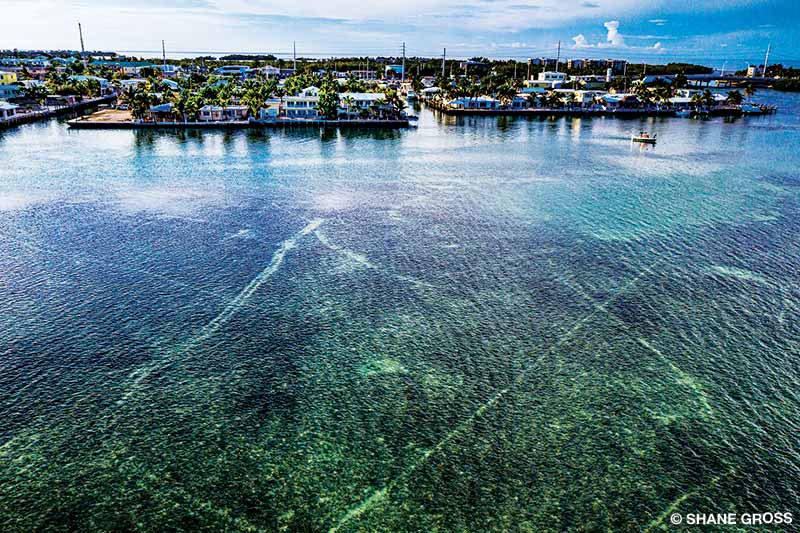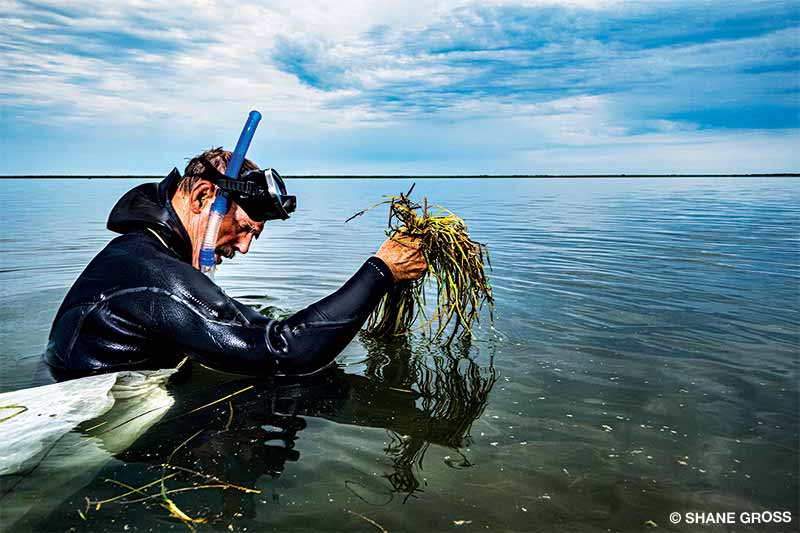Mengapa melindungi tanaman laut yang hampir punah ini sangat penting dalam upaya kita menyelamatkan iklim dan keanekaragaman hayati.
Saya mengangkat batu itu, dan kunci saya hilang. Saat itu tengah hari di bulan Juli, dan cuaca di Florida Keys sangat panas. Saya meneteskan air garam dan ada rumput laut di rambut saya. Ponsel, dompet, air minum, kunci hotel, kacamata hitam, dan semua yang saya bawa kecuali celana pendek dan kamera bawah air yang basah, tersegel di dalam mobil sewaan yang panas. Saya tahu saya telah meletakkan fob kunci di sana, dan saya telah mengawasi area tersebut dari tempat saya di dalam air. Tidak ada yang bisa mengambilnya, dan saya bertanya-tanya dengan tidak percaya di mana letaknya.
I had been sitting in a seagrass meadow, hoping a shy bonnethead shark would swim in front of my lens. These small hammerheads were reclassified in 2018 as the world’s first known omnivorous sharks. A central question facing scientists was how much of the seagrass nutrient content the sharks were taking in.
In one study led by Samantha Leigh, Ph.D., of California State University, Dominguez Hills, researchers fed captive bonnethead sharks a 90 percent seagrass diet for three weeks. Analysis of the sharks’ digestion showed they could get nutrients from the seagrass and exhibit growth on a primarily vegetarian diet. Since other marine omnivores have had positive effects on food webs, the researchers posited that the sharks’ nutrient intake meant we would “need to reevaluate the roles of bonnethead sharks in seagrass ecology because they could be responsible for significant grazing and nutrient transport within fragile seagrass ecosystems.”1

Hiu pemakan tumbuhan hanyalah salah satu contoh bagaimana ilmu pengetahuan mengubah pandangan kita tentang lamun dan mengungkapkan pentingnya lamun.
Seagrasses are different from algae and seaweed; they are more akin to flowering plants that grow on land. About 72 species are found in coastal seas on every continent except Antarctica, stretching from the equator to cool and cold areas — some Zostera marina tumbuh di Kutub Utara dan dapat bertahan hidup di bawah es.
A few weeks before I ended up keyless in the Florida heat, I was wearing a drysuit but still shivering in 35°F (1.7°C) water in Newfoundland, Canada. I had joined a small team of scientists from Fisheries and Oceans Canada (DFO) who have been monitoring the eelgrass and fish populations for decades.
In the early 1990s one of the world’s largest fisheries collapsed. A 1992 moratorium on cod fishing cost more than 30,000 jobs in Newfoundland. The Atlantic cod population had been mismanaged and was severely overfished. In the nearly 30 years since then, the population hasn’t returned to levels where commercial fishing can operate as it once did. Having ample seagrass habitats in which juveniles can hide and feed is one key to increasing cod numbers.

Many of the world’s major fisheries species depend on seagrass at some point in their life cycle. About 70 percent of the fishery species in Florida, for example, spend some time in seagrass.2
Seperti ikan kod Atlantik, ikan kod Atlantik pemalu di sekitar manusia. Saya memasang peralatan kamera bawah air saya pada tripod di depan padang lamun yang rimbun dan mundur, sementara tangan saya yang kedinginan menggenggam pelatuk jarak jauh.
A tiny Atlantic cod would occasionally flit in front of my lens, and I’d snap a picture. I joked with the team between dives and sips of hot chocolate how I was on my way to sunny Spain after this, simultaneously attempting to warm them up and make them jealous.
Off the Spanish coast of the Mediterranean Sea, I swam among one of the oldest and largest seagrass species on the planet — Posidonia oceanica. The plant’s root system is connected beneath the seafloor and stretches for more than 9 miles (14.5 km). Scientists estimate this organism could be up to 200,000 years old. The species is slow to recover from loss and has declined due to climate change and other human activity. Researchers are gathering data on its loss and areas where it is not declining, hoping that a better understanding will help reverse the trend.

Lamun mengalami penurunan di seluruh dunia. Beberapa perkiraan menunjukkan kehilangan keseluruhan hingga 7 persen per tahun sepanjang tahun 1990-an dan awal 2000-an.3 Faktor-faktor seperti polusi, pembangunan pesisir, berkurangnya kejernihan air, praktik penangkapan ikan, tambat, dan berperahu tertentu, dan tentu saja, perubahan iklim merupakan beberapa faktor yang berkontribusi terhadap penurunan tersebut.
In May 2019 I joined a team of volunteers and researchers from the Virginia Institute of Marine Science (VIMS) as they continued a 20-year seagrass restoration project using a technique developed by VIMS professor Robert “JJ” Orth, Ph.D. His seeding system is incredibly effective and has reestablished more than 9,000 acres of healthy eelgrass that has shown signs of developing into a full ecosystem. This method may be promising for regrowth elsewhere, but protecting what we still have should be the priority.
Manfaat melindungi lamun tidak dapat dilebih-lebihkan. Lamun memurnikan air, membantu melindungi dari erosi pantai, membantu mempertahankan perikanan skala kecil yang mendukung masyarakat, serta meningkatkan populasi ikan dan keanekaragaman hayati. Lamun menyerap lebih banyak karbon per area daripada hutan darat dan mengurangi pengasaman laut. Lamun yang sehat berarti laut yang lebih sehat.

With so much going for it, why aren’t dive tourists flocking to explore seagrass meadows? I’ve encountered toothy sharks and crocodiles, lovable dugongs and turtles, amazing seahorses and octopuses, strange lumpfish and horseshoe crabs, and many others among seagrass.
Back in Florida, a single bonnethead shark eventually swam up to my camera, took a quick look and disappeared. I had one usable photograph after nine days of patience. I never found my key. A crab probably dragged it down one of the many nearby holes — perhaps it was a bit of revenge from nature. If we let ourselves destroy too much of nature, I worry about its revenge against all of us. Let’s do what we can to protect our seagrass — that’s one key we don’t want to lose.
Catatan
1. Leigh SC, Papastamatiou YP, German DP. Seagrass digestion by a notorious ‘carnivore.’ Proceedings of the Royal Society B. 2018; 285(1886). doi.org/10.1098/rspb.2018.1583. royalsocietypublishing.org/doi/full/10.1098/rspb.2018.1583
2. Pentingnya lamun. Komisi Konservasi Ikan dan Satwa Liar Florida. myfwc.com/riset/habitat/ lamun/information/importance
3. Salinas C, Duarte CM, Lavery PS, dkk. Hilangnya lamun sejak pertengahan abad ke-20 memicu emisi CO2 emisi dari cadangan karbon tanah. Biologi Perubahan Global 2020; 26(9):4772–4784. doi.org/10.1111/gcb.15204. onlinelibrary.wiley.com/doi/full/10.1111/gcb.15204
Jelajahi Lebih Lanjut
Tonton video ini untuk mempelajari lebih lanjut tentang peran lamun dalam perubahan iklim.
© Alert Diver - Q3/Q4 2021